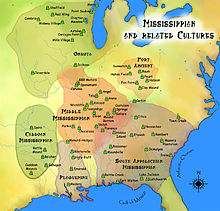 | |
| Geographical range | American Midwest |
|---|---|
| Period | Prehistoric, Protohistoric |
| Dates | c. 1000 — c. 1700 AD |
| Major sites | Oak Forest, Carcajou Point, Zimmerman, Anker, Fisher |
| Preceded by | Late Woodland |
| Followed by | New France |
The Upper Mississippian cultures were located in the Upper Mississippi basin and Great Lakes region of the American Midwest. They were in existence from approximately A.D. 1000 until the Protohistoric and early Historic periods (approximately A.D. 1700).[1][2]
Archaeologists generally consider "Upper Mississippian" to be an attenuated version of "Middle Mississippian" cultures represented at Cahokia and other sites exhibiting more complex social and political structures, perhaps at a chiefdom level of development. The Middle Mississippians were capable of forming large cities and were thus heavily dependent on agriculture to support large populations. This civilization had its origins about A.D. 1000 or slightly earlier, and was at its peak in the 12th and 13th centuries A.D. when the population at Cahokia was estimated to be 40,000 and the city itself covered an area of 3,480 acres (in contrast, Upper Mississippian sites are usually well under 10 acres). Although the Middle Mississippian declined after its peak, there were still advanced chiefdom-level societies present at the time of the DeSoto expedition in the 1530s and 1540s.[3][4]
The Upper Mississippians had their origins about the same time as the Middle Mississippians, around A.D. 1000. They attained larger populations and heavier emphasis on agriculture than the previous Late Woodland cultures but still relied to a large extent on hunting and gathering and lacked the chiefdom-level form of society and the large centralized cities. The Late Woodland peoples with their emphasis on small villages and hunting and gathering adaptation had previously occupied the Upper Mississippi Valley and Great Lakes Region prior to A.D. 1000. In some areas, the Late Woodland population persisted until European contact, and even occasionally coexisted in the same time and place with the Upper Mississippians.[5][3][1][2]
Most of the Upper Mississippian entities are grouped together under the Oneota aspect. The Grand River, Lake Winnebago, Koshkonong, Green Bay (aka Mero Complex), Orr and Utz are Foci grouped under Oneota. Fisher and Huber are placed by James A. Brown in an "unnamed tradition" (or focus) within the Oneota aspect. The Langford tradition is seen as contemporaneous with Fisher and Huber and is considered Upper Mississippian due to its similarity to Fisher material culture (especially pottery).[6][5][7] The Fort Ancient Aspect in the Ohio River Valley is sometimes considered an Upper Mississippian entity.[3]
- ^ a b Quimby, George Irving (1960). Indian Life in the Upper Great Lakes: 11,000 B.C. to A.D. 1800. Chicago, Illinois: University of Chicago Press.
- ^ a b Mason, Ronald J. (1981). Great Lakes Archaeology. New York, New York: Academic Press, Inc.
- ^ a b c Griffin, James Bennett (1943). The Fort Ancient Aspect: Its Cultural and Chronological Position in Mississippi Valley Archaeology (1966 ed.). Ann Arbor, Michigan: University of Michigan Museum of Anthropology.
- ^ Brose, David S. (1970). The Archaeology of Summer Island: Changing Settlement Systems in Northern Lake Michigan. Ann Arbor, Michigan: University of Michigan Museum of Anthropology, Anthropological Papers No. 41.
- ^ a b Brown, James A.; Asch, David L. (1990). "Chapter 4: Cultural Setting: the Oneota Tradition". In Brown, James A.; O'Brien, Patricia J. (eds.). The Oak Forest Site: Investigations into Oneota Subsistence-Settlement in the Cal-Sag Area of Cook County, Illinois, IN At the Edge of Prehistory: Huber Phase Archaeology in the Chicago Area. Kampsville, Illinois: Center For American Archaeology.
- ^ Griffin, John W. (1948). "Upper Mississippi at the Fisher Site". American Antiquity. 14 (2): 124–126. doi:10.2307/275224. JSTOR 275224. S2CID 164036868.
- ^ Hall, Robert L. (1962). The Archaeology of Carcajou Point. Madison, Wisconsin: University of Wisconsin Press.